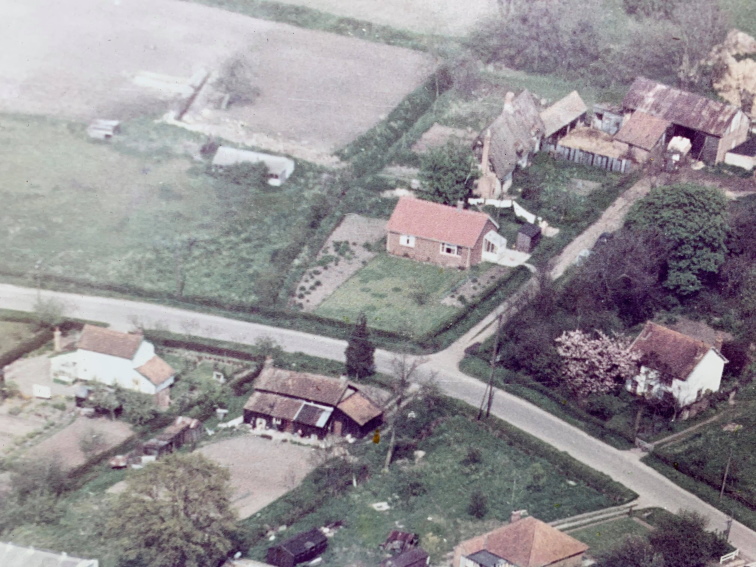
1960s Long Street with the old farmhouse of what was later known as Broadmarsh Farm to the top of the photograph with surrounding cottages. Fir Tree Farm is the white cottage to the right (as facing the photograph)
Courtesy of Michelle Baron
The Great Ellingham Inclosure documentation c.1802, tells us that Hannah Browne owned and occupied one messuage together with 30 acres of land. She also owned a cottage with an acre of land which was occupied by Edward Houchen and M. Balls.
The messuage and the cottage were in Long Street. The blue arrow on the below extract from the Inclosure Map of 1802 shows the ‘messuage’ occupied by Hannah Browne. The green arrow points to the cottage occupied by Edward Houchen and M. Balls.
The property later known as ‘Whitehouse Farm’ lies to the north of the cottage.
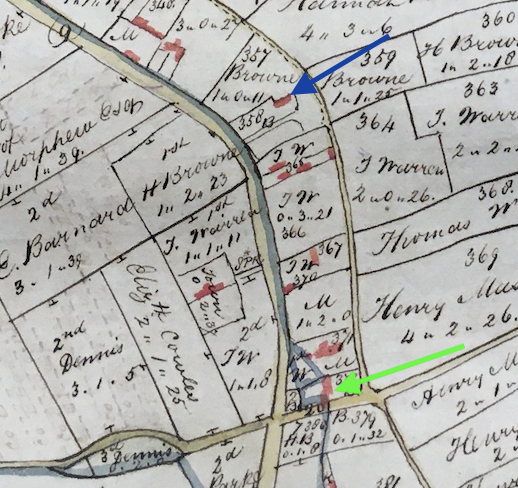
Extract from 1802 Map of Great Ellingham. Russell James Colman Plans. Norfolk Record Office Cat. Ref. C/Ca 1/84.
All rights reserved Norfolk Record Office. With kind permission of NRO
Earlier History
Prior to the Browne family’s ownership, the messuage (dwelling house with outbuildings and curtilage), was owned by Stephen Payn [also found as Payne or Pain(e)].
Although I have not seen conveyance deeds to confirm this, I believe that Stephen Payn acquired the property (probably by purchase) in 1687.
House
I understand that the farmhouse was demolished during the 1960s. However I do not know whether it was the very same house which stood on the land in 1687. Nevertheless, given that the photograph taken in the 1960s, suggests that the house may well have been ‘centuries old’ at that time, I think it more than possible. The house may well have had a similar look to several of the historical houses which remain standing in the village today.
Although the house and much of the farm’s land may well have been freehold, some of the land was copyhold. Accordingly, the Court Rolls (or Books) for the particular Manor will provide details of ownership of the pieces of copyhold land.
Benjamin Jarvis
If we can assume that the these pieces of copyhold land changed hands at the same time as the freehold house and land, it is possible to take the ownership of the house back further.
Benjamin Jarvis owned the copyhold land until his death around 1681. It follows that he may well have owned the house too.
Stephen Payn
A Mortgage Deed of 25th October, 1711, tells us that Stephen Payn lived in Wicklewood. Although there was a Payn family in Great Ellingham some decades earlier, I think it unlikely that Stephen Payn ever lived in the property. The deed also gives Payn’s occupation as ‘gentleman’. This indicates that Stephen Payn had some wealth and status. He did not have to work.
Nevertheless, Stephen Payn mortgaged the property to Edward Payn of Hingham. These two men may well have been related. The deed describes the property in Great Ellingham as “Messuage or tenement with houses, barns, stables, buildings, yards, orchards, gardens and homestall“. In addition, it included around 30 acres of land.
Zachariah Browne
On the 22nd March, 1724, Great Ellingham yeoman Zachariah Browne purchased the property.
Zachariah Browne was born around 1696. On the 19th October, 1724, he married Sarah Turner, the daughter of Edward and Mary Turner, at St Mary’s Church, Watton. The marriage register confirms that both Zachariah and Sarah were of Great Ellingham. Sarah was indeed born in the village in 1700.
I have no doubt that Zachariah and Sarah Browne lived in the farmhouse.
I do not know when the property became known as ‘Broadmarsh Farm’. Nevertheless for ease of reference, I refer to the farmhouse and premises as Broadmarsh Farm, whether or not it was known by that name at that time.
Children
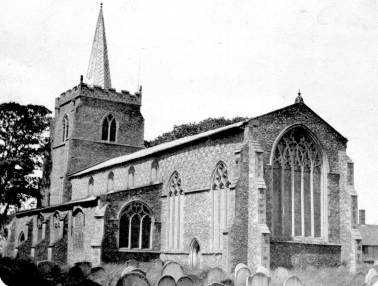
Church of St James, Great Ellingham
Zachariah and Sarah Browne had six known children.
On 29th August, 1725, their son Zachariah was baptised in St James’s Church. A year later, the couple took Sarah for baptism on the 3rd September, 1726. Edward was baptised on the 6 June 1730. However, I have not found baptisms for the other three children – Thomas, Mary and Hannah.
On the 8th January, 1746, Zachariah and Sarah buried their son Thomas in the churchyard of St James. Whilst the burial entry in the register confirms that Thomas is the son of Zachariah and Sarah Browne, there is no clue as to the child’s age.
However given that Sarah Browne died some six weeks later, I wonder whether there was a complication following Thomas’s birth. Having said that, Sarah Browne was 47 when she died – although it is not impossible for her to have borne another child. Nevertheless, it may be that Thomas and his mother succumbed to a similar illness. We will never know!
On the 28th April, 1766, Zachariah Browne buried his daughter Mary. This was some 20 years after the death of his wife Sarah. However (again) the burial entry does not provide Mary’s age, but does mention that she was a ‘single woman’.
Given that daughter Hannah was in her 80th year when she died in 1818, it follows that Hannah was born in 1738. Accordingly, Hannah was just 8 years old when her mother Sarah died.
Town Administration
In 1742, Zachariah Browne is one of five ‘Overseers of the Poor’ for the village. The other overseers were Edmund Chaplin, Samuel Williamson, Simon Warren and Thomas Beales. Zachariah would again be an overseer in 1746, 1752 and 1756.
The Town Accounts for 1744 show that the parish paid Zachariah Browne the sum of one pound for ‘keeping Sarah Masters’. We can only assume that the Browne family took in Sarah Masters and provided her with food and shelter.
In 1748, the ‘town’ paid 3/6d to Zachariah Browne in respect of ‘a debt due to him from this Town’.
In 1762, Zachariah held the position of one of two ‘Town Surveyors’. In 1764, he was both a churchwarden and an overseer.
The Town Accounts Book also shows that Zachariah was present at many of the Town Meetings relating to the town accounts.
Widower Zachariah Browne
Zachariah was around the age of 50 when his wife, Sarah, died in February 1746. His eldest son Zachariah was coming up to 21. His youngest child may have been no more than 8 years old.
In 1756, Zachariah’s eldest daughter Sarah married local man, Robert Houchin at St James’s Church. Robert and Sarah Houchin had three children(Robert, Edward and Ann) before Sarah died at the age of 35 in 1761.
By 1762, Zachariah’s eldest son, Zachariah, had moved to Upwell. He married Hannah Darrant in Upwell in 1762. The couple went on to have 7 known children, including son John born in 1770. Much later, John named his son Zachariah (born 1796).
Edward, Mary and Hannah remained with their father Zachariah Browne in Great Ellingham. Sadly, Mary died in 1766. This left Edward and Hannah at Broadmarsh Farm with their father. I have no doubt that both Edward and Hannah worked with their father on the farm.
Death of Zachariah Browne
On the 11th September, 1778, 82 year old Zachariah Browne signed his last will & testament. He died just under two years later.
On the 4th July, 1780, Zachariah was laid to rest in the churchyard of St James.
Brother and sister, Edward and Hannah Browne, inherited their father’s property, which included Broadmarsh Farm in which they each held a half-share. Neither of them had married.
Death of Edward Browne
On the 16th February, 1791, 61 year old farmer Edward Browne signed his last will & testament. Present at the signing were William Cady, Robert Houchin and William Cockell Jnr.
It seems that the will was made in some haste as, just six days’ later, Edward is buried in St James’s churchyard.
Edward Browne’s Will
It must have been some relief to Hannah that her brother, Edward, gave her a life interest in all his real estate which, of course, included his half-share of Broadmarsh Farm. It may be the case that they discussed this before Edward’s demise. However, Edward had only put this in writing a day or so before he died!
Hannah also received Edward’s personal estate but this was after the deduction of funeral expenses, the costs in connection with proving the will, and those legacies set out in his will which Edward charged on his personal estate.
Edward’s will is enlightening. He provides for his two illegitimate children – each referred to in the will as a ‘natural child’.
John Cockell
Hannah’s life interest in Edward’s real estate (including his half-share in Broadmarsh Farm), was subject to (and charged with) certain sums being paid to John Cockell, Edward’s ‘natural child’.
John, the son of spinster Susan Cockle, was baptised in St James’s Church on the 7th December, 1794. Even though the baptism took place after Edward Browne’s death, I do think that this baptism relates to Edward Browne’s illegitimate son. It appears that John Cockell was at least 4 years old at the time of his baptism.
John Cockell’s mother also benefitted from Edward Browne’s will. Edward bequeaths the sum of three guineas to single woman Susannah Cockell of Great Ellingham. Susannah to receive this sum within 6 weeks of Edward’s death and out of his personal estate.
Edward also provides for John Cockell to be given one shilling & sixpence per week until he reaches the age of 7, then two shillings & sixpence until the age of 10, and then the weekly sum of three shillings & sixpence until he reaches 14. This suggests that in 1791, John Cockell was under the age of 7.
In addition, John Cockell would receive £30 from the proceeds of the sale of Browne’s real estate. However this was only after the death of Hannah Browne and upon him reaching the age of 21. Until then, he would benefit from any interest earned on the sum until he reaches his majority.
Browne also charged his personal estate with the sum of £10. He directs his executors and trustees (Hannah Browne and Benjamin Turner) to apply the £10 to the ‘putting out’ of John Cockell in a trade or occupation which they and him (John Cockell) think appropriate.
Edward Towler
At the time of Edward Browne’s death, Edward Towler is working as a husbandman in Old Buckenham. Browne acknowledges Edward Towler as his ‘natural child’ and leaves him the sum of £20. However, this legacy would only be paid to him after the death of Hannah Browne and the subsequent sale of Edward Browne’s real estate (including his half-share in Broadmarsh Farm).
Other Legacies
Edward Browne also bequeathed the sum of £50 to each of John Browne, Thomas Browne and Elizabeth Browne, the surviving children of his eldest brother, Zachariah Browne. However, the legacies would be paid from the proceeds of the sale of Edward Browne’s real estate i.e. after the death of Hannah Browne.
Nevertheless, Edward Browne’s will did not deal with the residue of his estate i.e. what happens to any surplus monies following the sale of his real estate after the death of Hannah Browne. Nonetheless, this matter was dealt with in 1804.
Edward (Eddy) Houchin
Following the death of her brother Edward Browne, Hannah Browne continued to live at Broadmarsh Farm. As mentioned at the beginning of this article, Hannah let a nearby cottage with garden and hempland to her nephew Eddy (Edward) Houchen. Eddy is a son of Hannah’s late sister Sarah and her husband Robert Houchen.
Edward (Eddy) Houchen married Ursula Marjerham in St James’s Church on the 1st November, 1785. As far as I know, the couple remained living in Great Ellingham. They had three known children – Edward, Hannah and Robert.
Hannah Buys Out her Late Brother’s Share
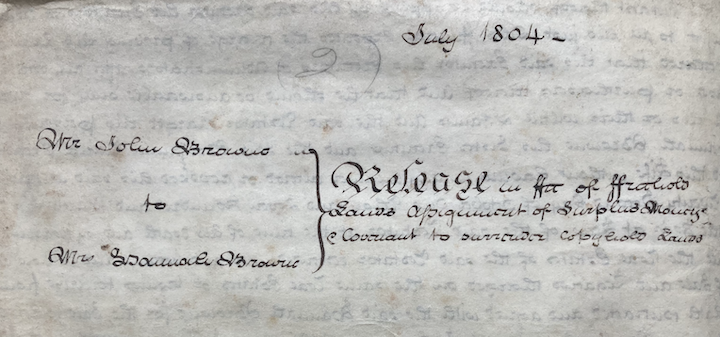
18th July 1804. Indenture of Release & Assignment. John Browne to Hannah Browne
Courtesy David & Julia Matthews
In 1804, Hannah Browne came to an agreement with her nephew, John Browne, a carpenter of March, Cambridgeshire, to purchase her late brother Edward’s share in Broadmarsh Farm. The agreement also included payment of the legacies from the proceeds of the sale of Edward Browne’s real estate (which included a half-share in Broadmarsh Farm).
Given that Edward Browne’s will failed to nominate a residuary beneficiary, Edward’s ‘heir at law’ was his nephew John Browne, being the eldest surviving son of his late eldest brother Zachariah.
On the 18th July, 1804, John Browne conveyed his late uncle Edward’s share in Broadmarsh Farm to Hannah Browne. The consideration paid was £30. Hannah agreed to include provision in her will for the legacies set out in her late brother Edward’s will to be settled from the sale of her real estate following her death.
Death of Hannah Browne
Hannah Browne died on the 8th August, 1818. A notice regarding her death published in the Norfolk Chornicle reads: “Saturday last in her 80th year Mrs. Hannah Browne, a maiden lady, of Great Ellingham“.
With her long life spanning the Georgian era, Hannah was likely born at Broadmarsh Farm where (it seems) she spent her entire life.
Hannah’s Last Will & Testament

Extract from the Probate of the Will and Codicil of Hannah Browne. Probate granted 18 May 1819 to William Ripper Coe
Courtesy David & Julia Matthews
Some 9 years earlier on the 20th December, 1809, spinster Hannah Browne put her ‘affairs in order’ and signed her will. However just a year later on the 15th December, 1810, Hannah amended part of the instructions by way of a codicil to her will following the death of her niece Elizabeth. Elizabeth was the daughter of Hannah’s late elder brother Zachariah and had married William Lee in 1800 in Upwell.

Extract from the Probate of the Will and Codicil of Hannah Browne. Probate granted 18 May 1819 to William Ripper Coe
Courtesy David & Julia Matthews
Executors
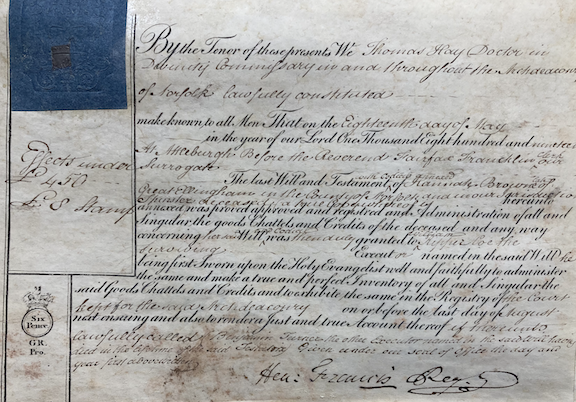
Extract from the Probate of the Will and Codicil of Hannah Browne. Probate granted 18 May 1819 to William Ripper Coe
Courtesy David & Julia Matthews
Hannah appointed William Ripper Coe of Attleborough and Benjamin Turner of Great Ellingham as her executors and administrators. Each of the executors to receive the sum of thirty guineas. As it happens, Benjamin Turner died during Hannah’s lifetime and the will was proved only by William Ripper Coe. In addition to his own thirty guineas, William Ripper Coe received Turner’s thirty guineas in default.
Real Estate
Hannah’s will provided for the sale of all her real estate (including, of course, Broadmarsh Farm). She directed her executors to pay off all her ‘just debts’ and to discharge all the legacies and sums of money referred to in her late brother Edward Browne’s will.
Legacies & Residuary Estate
Hannah gives £50 to each of her kinsmen Robert Houchin, cordwainer, of Great Ellingham and Edward (otherwise known as Eddy) Houchen, farmer, also of Great Ellingham.
The poor of the parish were not forgotten. Hannah directed her executors to distribute (at their absolute discretion) two guineas amongst ‘the poor persons residing in Great Ellingham’.
The remainder of the monies arising from the sale of Hannah’s real estate to be divided equally between – Robert Houchen, Eddy Houchen, Zachariah Browne of Upwell (the son of John Browne deceased, the son of Hannah’s late brother Zachariah), Thomas Browne (son of her late brother Zachariah) and Elizabeth, the wife of William Lee (and daughter of Hannah’s late brother Zachariah).
In the event, Elizabeth died before Hannah. Nevertheless in the codicil to Hannah’s will, Hannah directed her executors to pay Elizabeth’s share in her ‘residuary estate’ to Zachariah Browne. Further, the £50 due to Elizabeth from her late brother Edward Browne’s will, to be paid to Elizabeth’s husband William Lee.
Hannah’s Clothing & Household Items
Hannah Browne also left instructions with regard to her clothing and household effects. One moiety (share) of Hannah’s wearing apparel, household furniture, utensils or household plate, linen and china to be divided amongst the children of Hannah’s kinsman, Robert Houchen.
The other moiety to be divided amongst the children of her kinsmen, Eddy Houchen. The distribution to be made by Hannah’s executors at their discretion.
As it happens, the selection and distribution was carried out by the sole executor, William Ripper Coe. Probate was granted to him on the 18th May, 1819.
Sale of Broadmarsh Farm
Much of Hannah Browne’s real estate was offered for sale at auction in five lots. This was held on the 29th March, 1819, at The Cock Inn, Attleborough.
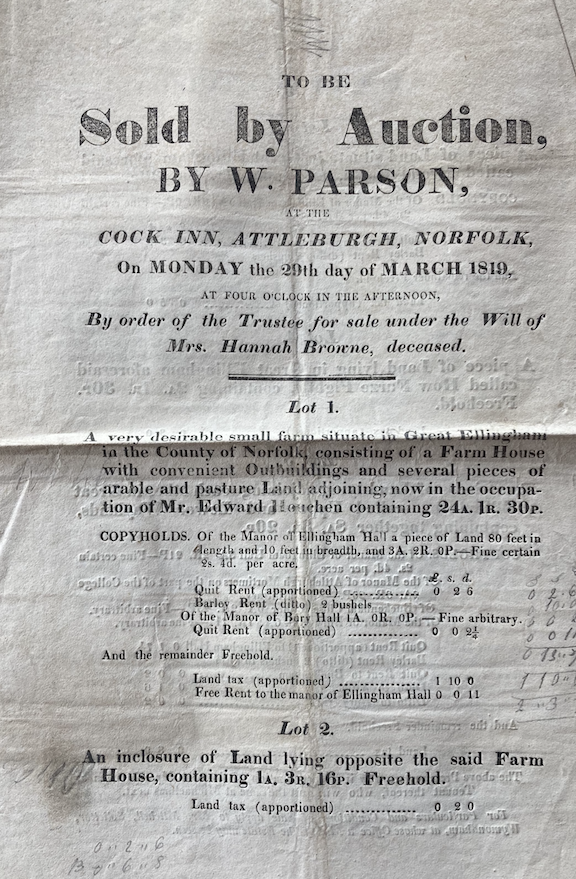
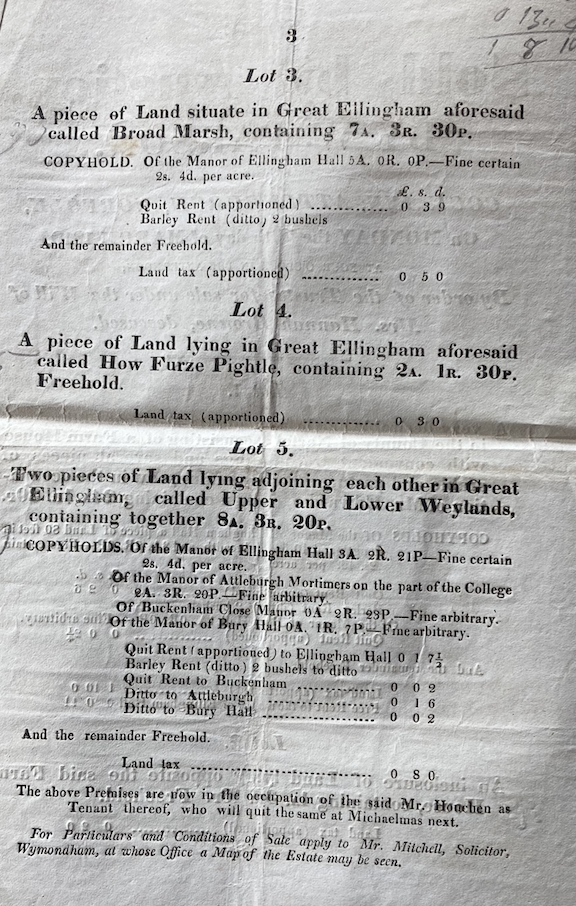
Extracts from the Auction Particulars & Conditions of Sale. 29th March 1819. Courtesy David & Julia Matthews
Consequently, Broadmarsh Farm would have a new owner.
Sources
Great Ellingham Parish Registers. Norfolk Record Office PD 609. Also available at FamilySearch.org
1802 Russell James Colman Plans. Great Ellingham. Norfolk Record Office. Catalogue Ref. C/Ca 1/84.
1799-1842 F W Horner, Records of the Surveyors to Commissioners for Inclosure in Parishes in Norfolk and Suffolk. Great Ellingham (Act 1799). Norfolk Record Office. Catalogue Ref: NRO, BR 90/2
1800 Inclosure Commissioner’s Particulars and Valuation, Great Ellingham. Norfolk Record Office. Catalogue Ref: NRO, MC 2213/119
Private Deeds Collection David & Julia Matthews, including the Probate of the will & codicil of Hannah Browne
Manor Court rolls for Lathes, Close Castle & Buckenham Priory 15959-1847. Viewed via family search.org
16 February 1791. Copy of the Probate of the Will of Edward Browne. Wymondham Town Archive Reference 124/106.
1741-1775. Great Ellingham Town Book. Norfolk Record Office. PD609/37.